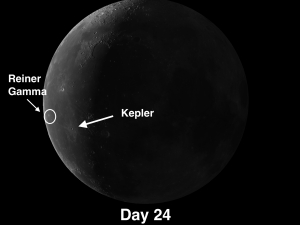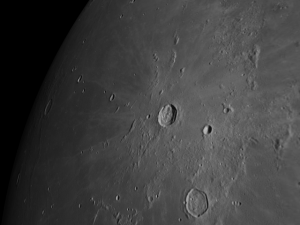The week of February 20-26 takes us from Day 24 to New Moon. This week we will highlight the crater Kepler, visible on Monday only. The Moon doesn’t rise on Monday until around 2:00 A.M., so viewing the Moon this week is reserved for the truly dedicated.
Kepler: [NW/J6] Kepler is a substantial 20-mile crater with terraced walls and some disappointingly feeble hills in place of a central mountain peak. There is a peculiar straight gash just in from the east rim which forms a long straight valley. Kepler has an impressive system of splash rays which intertwine with those of Aristarchus (visible tonight) and Copernicus (visible at full moon). Notice how Kepler’s longest western ray points directly to Reiner Gamma, the most famous of the Moon’s enigmatic lunar swirls. It has been suggested, somewhat mysteriously, that this is more than a coincidence.
OF ADDITIONAL INTEREST TO VIEW ON THE MOON FROM DAY 24 TO NEW MOON:
If you are fortunate enough to live under dark skies and aren’t too keen on observing the Moon at 3:00 A.M., this is a good week to try to observe the zodiacal light, a soft glow in a more-or-less triangular shape extending up from the western horizon near the sunset point as soon as it gets dark. This is sunlight that is scattered by dust in space along the ecliptic or zodiac. Although its feeble light is completely wiped out by moonlight or light pollution, if you were observing from interstellar distances the zodiacal light, incredibly, would be the brightest feature in the solar system besides the Sun! If you are successful, also try for the gegenschein, a faint oval of light directly opposite the Sun on the ecliptic.
For those of you who are new to this blog, the author has written a book on observing the Moon entitled What’s Hot on the Moon Tonight? The Ultimate Guide to Lunar Observing. It is a nightly guide to the Moon’s most interesting features as they are revealed throughout the lunar month. Much of the information in these blogs comes from this book.
I was fortunate in that Charles Wood, author of The Modern Moon: A Personal View, a writer for Sky & Tel, and one of the country’s foremost authorities on lunar observing, was willing to write the foreword. The book is available on Amazon and from my website, AndrewPlanck.com. (If you would like a signed copy, please order from my website.)
======================
It is highly recommended that you get a copy of Sky and Telescope’s Field Map of the Moon, the very finest Moon map available for use at the telescope. It is available for $10.95 at www.skyandtelescope.com and on Amazon. All features mentioned in this blog will be keyed to the grid on the Field Map and will look like this: Plato: [NW/D9]
Credits:
Courtesy of Gray Photography of Corpus Christi, Texas
Lunar photos: NASA / USGS / BMDO / LROC / ASU / DLR / LOLA / Moon Globe. Used by permission
- Rupes Cauchy: A Best Known Fault on the Moon - July 22, 2024
- Moon Crater Schickard – Crater Floor has Stripes - July 15, 2024
- Moon Craters Langrenus and Vandelinus - July 8, 2024


